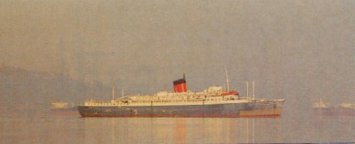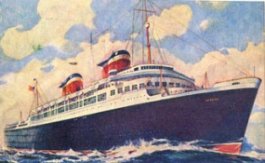 |
|
History of the America/West Point/Australis/American Star, Pt. 2 |
A New Name-A New Life.
D
emitrios Challioris explained how his career with Chandris had started. "I was in
charge of a crude oil tanker in Southampton, so we were having a reception with
guests from the Chandis family on board. 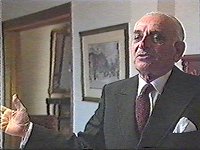 We
heard a voice asking us to go outside, wondering what was out there, we went
and I saw the America of the United States Line" Anthony
Chandris said to Demitrios "How would you like to be the Captain of that
ship? "Demitrios naturally replied "I would like it very much, but
you don't have any ships like this!" Anthony then said "I am going
to buy that ship" and he did! So this is how Demitrios Challioris became
the first Master of the ship under the Chandris flag...unbelievable but true.
Demitrios continues describing his Captains role. "Being the Captain on
such an enormous cruise liner was a very demanding job. Every morning you would
have to go out onto the deck, greet the passengers, kiss their foreheads, listen
to their wishes...and complaints. Very often I was with my wife, strolling together
on the deck, so I could easily approach a pretty woman and talk to her, pay
her a compliment and she would say, "Captain would you invite me to your
table tonight? "Madam, consider yourself invited". "There
were also other problems for me as a Captain. For instance the Panama Canal
was just wide enough for the size of the ship. When going through the locks
there was barely one metre left on each side. It was a very tough and stressful
situation, and there were around 8-10 locks to travel through".
We
heard a voice asking us to go outside, wondering what was out there, we went
and I saw the America of the United States Line" Anthony
Chandris said to Demitrios "How would you like to be the Captain of that
ship? "Demitrios naturally replied "I would like it very much, but
you don't have any ships like this!" Anthony then said "I am going
to buy that ship" and he did! So this is how Demitrios Challioris became
the first Master of the ship under the Chandris flag...unbelievable but true.
Demitrios continues describing his Captains role. "Being the Captain on
such an enormous cruise liner was a very demanding job. Every morning you would
have to go out onto the deck, greet the passengers, kiss their foreheads, listen
to their wishes...and complaints. Very often I was with my wife, strolling together
on the deck, so I could easily approach a pretty woman and talk to her, pay
her a compliment and she would say, "Captain would you invite me to your
table tonight? "Madam, consider yourself invited". "There
were also other problems for me as a Captain. For instance the Panama Canal
was just wide enough for the size of the ship. When going through the locks
there was barely one metre left on each side. It was a very tough and stressful
situation, and there were around 8-10 locks to travel through".
The largest passenger liner to have been bought by Chandris, or any other Greek
company at the time, Australis' new career was to take her back to the
Pacific where, 20 years before, she had provided such sterling service in less
peaceful times. Before commencing her new career Australis underwent
a major refit at Chandris's Piraeus yards. In order to provide an all one-class
configuration for a total of 2,300 passengers, she was rebuilt and modified
throughout, although her America personality was, in the main, kept intact.
Included in these changes were the extension of the aft Promenade decks to accommodate
extra cabin spaces, an external swimming pool upon the reworked stern Lido deck,
and the installation of air conditioning throughout all decks. On completion
during mid-1965 Australis was the largest one-class liner in the world.
Her original America capacity of 1046 berths had been more than doubled.
For the first three years of her career under the Chandris flag Australis
wore the house livery of all-white hull and superstructure. In 1968 this was
changed to a light grey hull and white upper-works-the only member of the fleet
to be so liveried
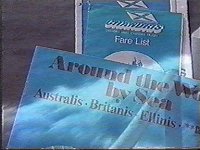 The Australis set off on her first voyage in August 1965. Thereafter, her customary routing
was on three-month voyages around the world: Bremerhaven, Rotterdam, Southampton,
Casablanca, Las Palmas, Cape Town,(or through the Mediterranean via Gibraltar,
Naples, Malta, Piraeus, Port Said and Aden), Freemantle, Melbourne, Sydney,
Auckland, Suva, Tahiti, Acapulco, Balboa, Cristobal, Port Everglades and return
to Southampton. She also cruised on occasions from Southampton to the Canaries,
Portugal, Spain, West Africa and sometimes into the Mediterranean. The prices
were just right for the times e.g. in September 1972 just £84 for a fortnight
from Southampton to Barcelona, Tangier, Gibraltar, Lanzarote, Tenerife, Madeira
and Lisbon. Chandris Lines had the Australian Government's prized migrant contract,
bringing scores of new settlers(who paid as little as £10 each) out to
Freemantle, Melbourne and Sydney. This usually meant that she was "sold
out" to every last berth(and especially with families and "shares"
in the larger 4 and-6 berth cabins on the lower decks). One staff member later
recalled, "those outward sailings were often so crowded that we had to
have three sittings for dinner and usually one just for the 500 or so children
that might be onboard." During 1967 Australis when bound for Australia,
was diverted from the Suez Canal transits to a more southerly passage which
was to include calls at Las Palmas and Cape Town. Once the Arab-Israeli conflict
was ended Australis again voyaged
The Australis set off on her first voyage in August 1965. Thereafter, her customary routing
was on three-month voyages around the world: Bremerhaven, Rotterdam, Southampton,
Casablanca, Las Palmas, Cape Town,(or through the Mediterranean via Gibraltar,
Naples, Malta, Piraeus, Port Said and Aden), Freemantle, Melbourne, Sydney,
Auckland, Suva, Tahiti, Acapulco, Balboa, Cristobal, Port Everglades and return
to Southampton. She also cruised on occasions from Southampton to the Canaries,
Portugal, Spain, West Africa and sometimes into the Mediterranean. The prices
were just right for the times e.g. in September 1972 just £84 for a fortnight
from Southampton to Barcelona, Tangier, Gibraltar, Lanzarote, Tenerife, Madeira
and Lisbon. Chandris Lines had the Australian Government's prized migrant contract,
bringing scores of new settlers(who paid as little as £10 each) out to
Freemantle, Melbourne and Sydney. This usually meant that she was "sold
out" to every last berth(and especially with families and "shares"
in the larger 4 and-6 berth cabins on the lower decks). One staff member later
recalled, "those outward sailings were often so crowded that we had to
have three sittings for dinner and usually one just for the 500 or so children
that might be onboard." During 1967 Australis when bound for Australia,
was diverted from the Suez Canal transits to a more southerly passage which
was to include calls at Las Palmas and Cape Town. Once the Arab-Israeli conflict
was ended Australis again voyaged 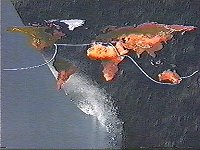 (during
February 1976) by the Suez routing. In the meantime P&O had ceased the line-voyage
operations by Canberra and Oriana in 1975, causing Australis to be awarded the
title of "the world's largest express liner" in regular scheduled
service. Externally Australis underwent many alterations during her career
with Chandris. The most obvious was the 1969 removal of her main-mast. In lieu,
a short mast was fitted atop her aft-and functional-funnel along with a box-like
structure deemed neccessary to disperse exhaust smoke. Also during those years
extra passenger capacity was built within the shells of larger stateroom accommodation.
However, her imposing public rooms remained basically unchanged. Aboard Australis
were perhaps some of the greatest surviving examples of 'American Moderne'decor
to exist in the seventies. The ships many murals, bas reliefs, her lacquer-work,
add bold-yet intricate-Art deco floor coverings were evidence of that `tween-wars
era when style and elegance really counted. Apart from the various signs by
the stairs and public rooms, vestigal remains of the America era that
were still very much in evidence were Pierre Bourdelle's 24 lacquer panels in
the Atlantic restaurant and Hildreth Meire's chrome and copper reliefs in the Pacific restarant. On all stairways
Austin Purves' sculptured aluminium zodiac motifs remained the principal artistic
features.
(during
February 1976) by the Suez routing. In the meantime P&O had ceased the line-voyage
operations by Canberra and Oriana in 1975, causing Australis to be awarded the
title of "the world's largest express liner" in regular scheduled
service. Externally Australis underwent many alterations during her career
with Chandris. The most obvious was the 1969 removal of her main-mast. In lieu,
a short mast was fitted atop her aft-and functional-funnel along with a box-like
structure deemed neccessary to disperse exhaust smoke. Also during those years
extra passenger capacity was built within the shells of larger stateroom accommodation.
However, her imposing public rooms remained basically unchanged. Aboard Australis
were perhaps some of the greatest surviving examples of 'American Moderne'decor
to exist in the seventies. The ships many murals, bas reliefs, her lacquer-work,
add bold-yet intricate-Art deco floor coverings were evidence of that `tween-wars
era when style and elegance really counted. Apart from the various signs by
the stairs and public rooms, vestigal remains of the America era that
were still very much in evidence were Pierre Bourdelle's 24 lacquer panels in
the Atlantic restaurant and Hildreth Meire's chrome and copper reliefs in the Pacific restarant. On all stairways
Austin Purves' sculptured aluminium zodiac motifs remained the principal artistic
features. 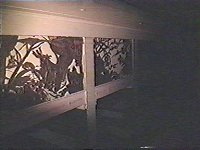 In the ship's Cocktail Lounge Constantin Alajalov's three murals on
the ceiling depicted the liner's passenger's life by day and night activities.
Beneath each mural the International code flags spelt
In the ship's Cocktail Lounge Constantin Alajalov's three murals on
the ceiling depicted the liner's passenger's life by day and night activities.
Beneath each mural the International code flags spelt `
America,'
Chandris Lines, like P&O and many others before them, had realised
the unprofitability of maintaining such a large liner upon a slow and diminishing
market. Following Lloyd Triestro's cancellation of Galileo Galilei and Guglielmo
Marconi voyages, The Australis had become the sole remaining liner on the trade.
Chandris Lines had just over a decade of extremely profitable services on the
Australian trade route. By 1977, howerver, Chandris had lost the Government contract
(thereafter new settlers would go by jet plane). and so, that November, she made her
last voyage out to Sydney. Then she was laid-up at an anchorage in rather remote
Timaru in New Zealand. There was uncertainty, just as there had been in 1964,
about her future. Some believed that she would make only one further voyage: to
the Far East and those ever-hungry scrappers at Kaohsiung Taiwan.
Venture
forward.
In the spring of 1978, however, and with the hope of cashing-in on the booming
short cruise business out of the US East Coast ports, particularly New York,
several American investors offered to buy the idle Australis for $5 million.
The offer was promptly accepted and so she was "steamed up" and sailed
via Panama for New York. Once there, in late May, she was sent to the big graving
dock in 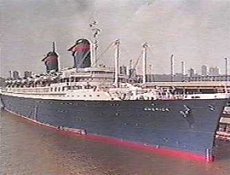 Bayonne
for inspection. The hull and machinery were said to be in fine condition-in
fact the words "amazing" and "excellent" were used by several
experts. It was a great testament to her original construction some forty years
before. Otherwise, little else was done. The investors were satisfied and, once
again, the sales contracts were signed. Then, the new owners decided to rename
her America, to capitalize on the ship's illustrious heritage. The new
operators were even listed as American Cruise Lines, but then a small, Connecticut-based
operation, which ran coastal cruise ships, objected in court and so the America's
new owners were soon relisted as Venture Cruise Lines.
Bayonne
for inspection. The hull and machinery were said to be in fine condition-in
fact the words "amazing" and "excellent" were used by several
experts. It was a great testament to her original construction some forty years
before. Otherwise, little else was done. The investors were satisfied and, once
again, the sales contracts were signed. Then, the new owners decided to rename
her America, to capitalize on the ship's illustrious heritage. The new
operators were even listed as American Cruise Lines, but then a small, Connecticut-based
operation, which ran coastal cruise ships, objected in court and so the America's
new owners were soon relisted as Venture Cruise Lines.
The schedule of short cruises-3 days to "nowhere", 4-and 5 day trips to Halifax
and 5-day runs to Nassau-had barely begun when there were problems, in fact
very serious problems. They seemed rather inevitable. She was berthed at Pier
92, at the foot of New York's West 52nd. Street. In early days, that terminal
had been used by Cunard, but was now part of a six-berth consolidated cruise
centre. Once passengers were aboard, most noticeable was the ship's near filthy
condition: small mountains of soiled linen and masses of well worn mattresses,
scattered bundles of rubbish and, just about everywhere was a stale stench-a
foul mixture of kitchen odours, engine oils and plumbing backups. Evidently,
there had been some run down and deferred maintenance even in her final Chandris
passenger days. It seemed so inappropriate for a once sparkling liner. The outer
decks were also in deep decay, suffering from the ill effects of long overdue
care. There was rust, leaking water from overhead pipes and even holes caused
by corrosion in the "dummy" forward funnel. Noticeably,
there were far too many layers of paint slapped over the outer bulkheads, on
the rails and-most alarmingly-on the davits and lifeboat gear. College students,
employed at minimum rates, had carelessly painted some of the Public
rooms, the once impeccable stainless steel trims were scarred by brush strokes.
Most obviously, the ship needed weeks, if not months, of proper care-and all of it
conducted at a proper shipyard. Alternatively, it seemed that she might best be sent on to the scrappers.
On the 30th June, however, and booked with some 900 passengers that responded to the overly
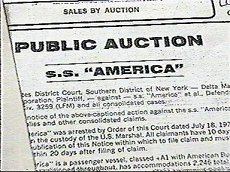 enthusiastic,
high spirited newspaper advertising by Venture Cruise Lines, and by the $75-a-day rates, followed with horrific reports of inadequate food, plumbing problems, ill-trained staff, uncleanliness and, perhaps most
damaging, reports of cockroaches and even rats seen throughout the passenger areas. Somehow, she managed a second cruise, a 5-day run up to Halifax, but the same complaints followed-and along with reports of rubbish being stored
in the outdoor pool. The old America was defaced and ruined completely.
Her owners had already incurred over $500, 000 worth of fines. Promptly, Venture
Cruise Lines closed their doors and declared bankruptcy.
enthusiastic,
high spirited newspaper advertising by Venture Cruise Lines, and by the $75-a-day rates, followed with horrific reports of inadequate food, plumbing problems, ill-trained staff, uncleanliness and, perhaps most
damaging, reports of cockroaches and even rats seen throughout the passenger areas. Somehow, she managed a second cruise, a 5-day run up to Halifax, but the same complaints followed-and along with reports of rubbish being stored
in the outdoor pool. The old America was defaced and ruined completely.
Her owners had already incurred over $500, 000 worth of fines. Promptly, Venture
Cruise Lines closed their doors and declared bankruptcy.
The worn-out, scarred America spent the remaining weeks of that summer at
her pier 92 berth. Some onlookers occasionally thought of her earlier days,
of better times for the ship, of those colourful and splendid gatherings of
Atlantic liners along "Luxury Liner Row". In late August, the New York City
Bankruptcy Court Marshals and their agents went aboard and, in view of her debts,
auctioned-off the 38-year-old liner. Surprisingly, the buyers were Chandris
Lines and the price was an amazing $1 million, or $4 million less than the amount
for which they sold her four months earlier! A skeleton crew was mustered and,
on the 6th. September 1978, largely unnoticed, the America slipped out
of New York, certainly for the very last time, bound for Piraeus.
The ship was, once again, moored in Perama Bay, in those extraordinary, but haphazard
anchorage's and nestings of ships owned by Greek shippers. Some of her neighbours
at the time included several well known passenger ships: the Chandris Ellinis,
the former Norwegian American Bergensfjord, the Greek Line Olympia,
Furness Bermuda's one time Ocean Monarch and, amongst them the oldest
of all, Grace Line's Santa Paula of 1932. There seemed to be little hope
for many of these ships, but there was some further repairs made to the America
and then-with her forward funnel gone in the process-she reappeared as the Italis.
She was advertised as the "Italian lady" for charter Mediterranean cruises
out of Barcelona and Genoa. but this too was short-lived. By the autumn of 1979
she was, once again, out of service, so went back to her moorings in Perama
Bay. Her commercial days seemed to be over. the old ship had been in decay, lonely and rusting, there had been the inevitable
rumours, of course, as with the one-time fleetmate United States, which has
been laid-up and equally neglected on the other side of the Atlantic. There
was reports that the America would become a floating hotel in a West
African port, then a "floating prison" at Galveston, Texas and even
one wildly enthusiastic report that she would return to New York waterfront,
but as a restored "luxury hotel"-the Hotel America! In May
1980, she was sold to the Inter Commerce Corporation, a Swiss-backed arm of
the Panamanian-flag company Noga d'Importation et d'Exportation. Then renamed
Noga, she remained at her Greek moorings. Silver Moon Ferries Ltd were
her new owners in 1984, renaming her Alferdoss (Which meant "paradise"
in Arabic). Her end nearly came in October 1988, when one of her underwater
bilge pumps rusted through, flooding the engine room and causing her to list
to port. She was ultimately beached and pumped dry. Later a scrap merchant offered
$2 million for her. After the owner had accepted $1 million as a deposit, a
team of workers came onboard and began dismantling. However, the scrap merchant
defaulted on the balance, demolition work was halted and the old America cheated fate once again.

The ex-"Australian Lady" was laid-up in Eleusis Bay, Greece from 1980 until she was sold in 1992.
The above two pictures were supplied courtesy of Lia and Aris Bilalis.

Miraculously, in October 1992, after almost 12 years in lay-up, Alferdoss was bought
for $2 million by a Thai company, to be used as a floating 5-star hotel at Phuket.
Renamed American Star, she entered dry dock for a period of 68 days to
allow workmen to fully prepare her for the long tow (View photos, sketches and plans from 1993), which was expected to take
100 days, with an average speed of 5.5 knots. The Ukranian flag tug, Neftegaz
67, was contracted to make the giant tow and by the late afternoon of Christmas
Eve, 1993, the two vessels left Piraeus roads. Less than 24 hours after departure,
due to very bad weather, American Star was yawing side to side and was
sometimes overpassing the tug. The vessel returned the day after in the early
afternoon, to wait for the weather to calm down and for adjustments to be made
to the towing rig. They sailed again on New Years Eve and passed Gibralter on
12 January in perfect towing conditions. It was just off the Canary islands
that the weather deteriorated and on Saturday 15th January the tow line snapped.
The following day the tug crew succeeded in attaching an emergency tow line.
Unfortunately, the bad weather, with force 12 winds, caused the emergency tow
line to break. In order to save the ship, Ukranian sailors were sent aboard
American Star and tried to connect two polypropylene ropes to the tug.
Unfortunately, these also broke and finally the sailors had to be lifted off
the liner by helicopter. Early on the 18th January, American Star went
aground on the west coast of the island of Fuerteventura and 48 hours later
she was broken in two. Declared a total loss, she was left to the elements to
finally claim her.
Shortly
after the grounding, the liner was pillaged by the locals of all fittings, art,
brass, and removable wood, and the stern section began a gradual collapse into
the water. The bow section has so far held on, defying the elements to this
day.
Welcome all visitors to the S.S. Australis Website, which has now been online since 1998!
I will continue to update the site if I receive a new story, or if you have interesting photos taken on the ship during your voyage
on either the southbound, northbound, or on one of the South Pacific cruises. We used to do those trips several times a year
from Melbourne, Sydney and Auckland (New Zealand).
I am deeply moved by the interest and wonderful contributions from the numerous passengers and crew over many years.
You can send an e-mail to me on the link below: 
A HUGE THANK YOU
Warm Regards
Ken
|


 We
heard a voice asking us to go outside, wondering what was out there, we went
and I saw the America of the United States Line" Anthony
Chandris said to Demitrios "How would you like to be the Captain of that
ship? "Demitrios naturally replied "I would like it very much, but
you don't have any ships like this!" Anthony then said "I am going
to buy that ship" and he did! So this is how Demitrios Challioris became
the first Master of the ship under the Chandris flag...unbelievable but true.
Demitrios continues describing his Captains role. "Being the Captain on
such an enormous cruise liner was a very demanding job. Every morning you would
have to go out onto the deck, greet the passengers, kiss their foreheads, listen
to their wishes...and complaints. Very often I was with my wife, strolling together
on the deck, so I could easily approach a pretty woman and talk to her, pay
her a compliment and she would say, "Captain would you invite me to your
table tonight? "Madam, consider yourself invited". "There
were also other problems for me as a Captain. For instance the Panama Canal
was just wide enough for the size of the ship. When going through the locks
there was barely one metre left on each side. It was a very tough and stressful
situation, and there were around 8-10 locks to travel through".
We
heard a voice asking us to go outside, wondering what was out there, we went
and I saw the America of the United States Line" Anthony
Chandris said to Demitrios "How would you like to be the Captain of that
ship? "Demitrios naturally replied "I would like it very much, but
you don't have any ships like this!" Anthony then said "I am going
to buy that ship" and he did! So this is how Demitrios Challioris became
the first Master of the ship under the Chandris flag...unbelievable but true.
Demitrios continues describing his Captains role. "Being the Captain on
such an enormous cruise liner was a very demanding job. Every morning you would
have to go out onto the deck, greet the passengers, kiss their foreheads, listen
to their wishes...and complaints. Very often I was with my wife, strolling together
on the deck, so I could easily approach a pretty woman and talk to her, pay
her a compliment and she would say, "Captain would you invite me to your
table tonight? "Madam, consider yourself invited". "There
were also other problems for me as a Captain. For instance the Panama Canal
was just wide enough for the size of the ship. When going through the locks
there was barely one metre left on each side. It was a very tough and stressful
situation, and there were around 8-10 locks to travel through".
 The Australis set off on her first voyage in August 1965. Thereafter, her customary routing
was on three-month voyages around the world: Bremerhaven, Rotterdam, Southampton,
Casablanca, Las Palmas, Cape Town,(or through the Mediterranean via Gibraltar,
Naples, Malta, Piraeus, Port Said and Aden), Freemantle, Melbourne, Sydney,
Auckland, Suva, Tahiti, Acapulco, Balboa, Cristobal, Port Everglades and return
to Southampton. She also cruised on occasions from Southampton to the Canaries,
Portugal, Spain, West Africa and sometimes into the Mediterranean. The prices
were just right for the times e.g. in September 1972 just £84 for a fortnight
from Southampton to Barcelona, Tangier, Gibraltar, Lanzarote, Tenerife, Madeira
and Lisbon. Chandris Lines had the Australian Government's prized migrant contract,
bringing scores of new settlers(who paid as little as £10 each) out to
Freemantle, Melbourne and Sydney. This usually meant that she was "sold
out" to every last berth(and especially with families and "shares"
in the larger 4 and-6 berth cabins on the lower decks). One staff member later
recalled, "those outward sailings were often so crowded that we had to
have three sittings for dinner and usually one just for the 500 or so children
that might be onboard." During 1967 Australis when bound for Australia,
was diverted from the Suez Canal transits to a more southerly passage which
was to include calls at Las Palmas and Cape Town. Once the Arab-Israeli conflict
was ended Australis again voyaged
The Australis set off on her first voyage in August 1965. Thereafter, her customary routing
was on three-month voyages around the world: Bremerhaven, Rotterdam, Southampton,
Casablanca, Las Palmas, Cape Town,(or through the Mediterranean via Gibraltar,
Naples, Malta, Piraeus, Port Said and Aden), Freemantle, Melbourne, Sydney,
Auckland, Suva, Tahiti, Acapulco, Balboa, Cristobal, Port Everglades and return
to Southampton. She also cruised on occasions from Southampton to the Canaries,
Portugal, Spain, West Africa and sometimes into the Mediterranean. The prices
were just right for the times e.g. in September 1972 just £84 for a fortnight
from Southampton to Barcelona, Tangier, Gibraltar, Lanzarote, Tenerife, Madeira
and Lisbon. Chandris Lines had the Australian Government's prized migrant contract,
bringing scores of new settlers(who paid as little as £10 each) out to
Freemantle, Melbourne and Sydney. This usually meant that she was "sold
out" to every last berth(and especially with families and "shares"
in the larger 4 and-6 berth cabins on the lower decks). One staff member later
recalled, "those outward sailings were often so crowded that we had to
have three sittings for dinner and usually one just for the 500 or so children
that might be onboard." During 1967 Australis when bound for Australia,
was diverted from the Suez Canal transits to a more southerly passage which
was to include calls at Las Palmas and Cape Town. Once the Arab-Israeli conflict
was ended Australis again voyaged  (during
February 1976) by the Suez routing. In the meantime P&O had ceased the line-voyage
operations by Canberra and Oriana in 1975, causing Australis to be awarded the
title of "the world's largest express liner" in regular scheduled
service. Externally Australis underwent many alterations during her career
with Chandris. The most obvious was the 1969 removal of her main-mast. In lieu,
a short mast was fitted atop her aft-and functional-funnel along with a box-like
structure deemed neccessary to disperse exhaust smoke. Also during those years
extra passenger capacity was built within the shells of larger stateroom accommodation.
However, her imposing public rooms remained basically unchanged. Aboard Australis
were perhaps some of the greatest surviving examples of 'American Moderne'decor
to exist in the seventies. The ships many murals, bas reliefs, her lacquer-work,
add bold-yet intricate-Art deco floor coverings were evidence of that `tween-wars
era when style and elegance really counted. Apart from the various signs by
the stairs and public rooms, vestigal remains of the America era that
were still very much in evidence were Pierre Bourdelle's 24 lacquer panels in
the Atlantic restaurant and Hildreth Meire's chrome and copper reliefs in the Pacific restarant. On all stairways
Austin Purves' sculptured aluminium zodiac motifs remained the principal artistic
features.
(during
February 1976) by the Suez routing. In the meantime P&O had ceased the line-voyage
operations by Canberra and Oriana in 1975, causing Australis to be awarded the
title of "the world's largest express liner" in regular scheduled
service. Externally Australis underwent many alterations during her career
with Chandris. The most obvious was the 1969 removal of her main-mast. In lieu,
a short mast was fitted atop her aft-and functional-funnel along with a box-like
structure deemed neccessary to disperse exhaust smoke. Also during those years
extra passenger capacity was built within the shells of larger stateroom accommodation.
However, her imposing public rooms remained basically unchanged. Aboard Australis
were perhaps some of the greatest surviving examples of 'American Moderne'decor
to exist in the seventies. The ships many murals, bas reliefs, her lacquer-work,
add bold-yet intricate-Art deco floor coverings were evidence of that `tween-wars
era when style and elegance really counted. Apart from the various signs by
the stairs and public rooms, vestigal remains of the America era that
were still very much in evidence were Pierre Bourdelle's 24 lacquer panels in
the Atlantic restaurant and Hildreth Meire's chrome and copper reliefs in the Pacific restarant. On all stairways
Austin Purves' sculptured aluminium zodiac motifs remained the principal artistic
features.  In the ship's Cocktail Lounge Constantin Alajalov's three murals on
the ceiling depicted the liner's passenger's life by day and night activities.
Beneath each mural the International code flags spelt `America,'
In the ship's Cocktail Lounge Constantin Alajalov's three murals on
the ceiling depicted the liner's passenger's life by day and night activities.
Beneath each mural the International code flags spelt `America,' Bayonne
for inspection. The hull and machinery were said to be in fine condition-in
fact the words "amazing" and "excellent" were used by several
experts. It was a great testament to her original construction some forty years
before. Otherwise, little else was done. The investors were satisfied and, once
again, the sales contracts were signed. Then, the new owners decided to rename
her America, to capitalize on the ship's illustrious heritage. The new
operators were even listed as American Cruise Lines, but then a small, Connecticut-based
operation, which ran coastal cruise ships, objected in court and so the America's
new owners were soon relisted as Venture Cruise Lines.
Bayonne
for inspection. The hull and machinery were said to be in fine condition-in
fact the words "amazing" and "excellent" were used by several
experts. It was a great testament to her original construction some forty years
before. Otherwise, little else was done. The investors were satisfied and, once
again, the sales contracts were signed. Then, the new owners decided to rename
her America, to capitalize on the ship's illustrious heritage. The new
operators were even listed as American Cruise Lines, but then a small, Connecticut-based
operation, which ran coastal cruise ships, objected in court and so the America's
new owners were soon relisted as Venture Cruise Lines. enthusiastic,
high spirited newspaper advertising by Venture Cruise Lines, and by the $75-a-day rates, followed with horrific reports of inadequate food, plumbing problems, ill-trained staff, uncleanliness and, perhaps most
damaging, reports of cockroaches and even rats seen throughout the passenger areas. Somehow, she managed a second cruise, a 5-day run up to Halifax, but the same complaints followed-and along with reports of rubbish being stored
in the outdoor pool. The old America was defaced and ruined completely.
Her owners had already incurred over $500, 000 worth of fines. Promptly, Venture
Cruise Lines closed their doors and declared bankruptcy.
enthusiastic,
high spirited newspaper advertising by Venture Cruise Lines, and by the $75-a-day rates, followed with horrific reports of inadequate food, plumbing problems, ill-trained staff, uncleanliness and, perhaps most
damaging, reports of cockroaches and even rats seen throughout the passenger areas. Somehow, she managed a second cruise, a 5-day run up to Halifax, but the same complaints followed-and along with reports of rubbish being stored
in the outdoor pool. The old America was defaced and ruined completely.
Her owners had already incurred over $500, 000 worth of fines. Promptly, Venture
Cruise Lines closed their doors and declared bankruptcy.